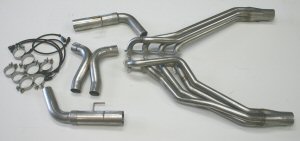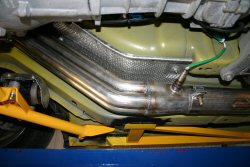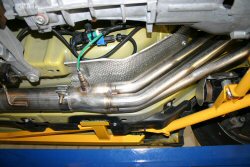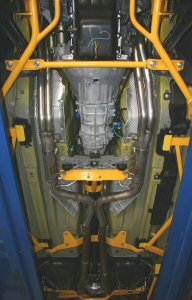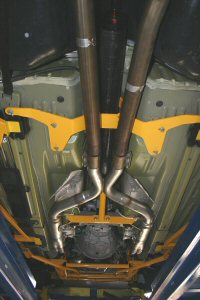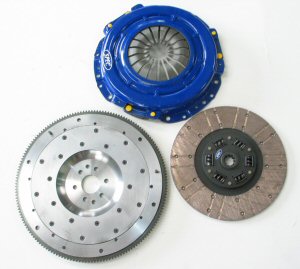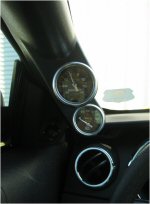| BMR Homepage |
| -Page 1 |
| -Page 2 |
| -Page 3 |
| -Page 4 |
| -Page 5 |
MARCH 2006
| Next on the mod list is a set of Stainless Works 1-5/8" full-length headers. This is probably a questionable mod since we plan to run turbos but we had a good opportunity to use a set so we decided to put them on and see what they would do. In any other application using a power adder, it would be recommended to use the larger 1-3/4" version but for any naturally aspirated motor, the 1-5/8" flows more than enough. |
The Stainless Works kit was very nice to work with and the headers went in easily and fit well. We opted for the merged x-pipe when ordering the kit and would recommend this option for every installation where emissions is not an issue. The kit comes with band-style clamps, oxygen sensor extensions and all the pipes necessary to bolt to the existing exhaust.
|
Note how well the headers contour and mimic the
angle of the frame rails. They also don't hang any lower than the
framerail itself.
|
Florida is an emissions exempt state so we were able to eliminate the catalytic converters in this application. The images below show the final fit with the installation complete. Since we will be adding a turbo system and the entire exhaust is the primary inlet pipe to the turbos, we welded the x-pipe connectors together to minimize potential exhaust leaks. The band style clamps still provide disconnect points at the header collectors and in the rear exhaust connections.
|
With the installation complete, the car was driven down to Modular Madness in Sarasota for tuning and another dyno pull. The car sounded good and felt a lot quicker without being much louder. It has a throatier sound now and feels more throttle responsive than before. Before adjusting the tune, we put it on the rollers and made a pull. It made 290.4 rwhp and 308.3 rwtq. Nice, almost 300! The air/fuel ratio was just a little lean on that pull indicating that it did need a tune to compensate for the increased airflow. Don adjusted the ratio and made another pull with the car. It only picked up another 2.4 rwhp from the tune but overall this mod was worth a total of 15.8 rear wheel horsepower and 12.9 rear wheel torque. Final figures are 292.82hp and 308.31tq. We all agree that an aftermarket air inlet would push these figures over the 300 mark. |
MARCH 2006 cont.
With the newfound horsepower from the combined mods, we decided to take the car to the track and see what kind of times it would turn. We were'nt expecting too much since the car is geared (and tired) for the turbos but we felt it should run some low 13's. On the first pass, we did a small burnout just to clean the tires off and left around 3800 rpm. The car bogged and fell flat on it's face, running a 13.4 @ 103mph. Ok, but it was obvious we needed to leave harder. On the next pass we left at 4800. The car still bogged and felt like the clutch may have been slipping on the 3-4 shift. Since we drove the car to the track, we decided not to push it any further without a clutch. The car ran a 13.2@104.8mph. With the right gearing and a clutch, it could easily run 12.80's. We basically confirmed what our next mod should be.
APRIL 2006
Since the last update, we received the STS turbo kit and expected to have it installed by now, unfortunately we ran in to a few snags. It was immediately apparent that our subframe connectors and their turbo kit were NOT going to coincide under the car. We basically went through every scenario possible to make it work but were defeated in the end. The kit was shipped back and we began determining if we wanted to build our own turbo kit or buy a bolt-in kit from someone. It was about this time that one of our distributors, Speed Inc., let us know they were developing an '05 single turbo kit and that it would probably be ready sometime around early summer. Perfect. The car is scheduled to go on the Hot Rod Power Tour in June and will ship to Speed Inc. as soon as the tour is over.
MAY 2006
|
We decided to go with a Spec Stage 3+ clutch after hearing many good things about them. This setup is streetable and rated to 800 ft/lbs. of torque which should be plenty even if we want to upgrade the motor and step up the boost. We also decided to use one of their aluminum flywheels with the clutch. The combined total of all three weighs 2 lbs. more than stock. The clutch has a nice feel. Pedal effort is very similar to stock however the clutch engages instantly with very little slip. It's definitely streetable, it just takes a little getting used to. The car leaves for the Hot Rod Power Tour in two weeks so the clutch will get a good break-in and even make a few passes in Gainesville and Englishtown. |
MARCH 2007
No updates from May '06 to March '07? What's up? By now I am sure that most of you probably thought we had given up on the car but I can assure you that is not the case. Here is what has happened in the last 9 months. In June '06 the car drove the distance on the Hot Rod Power Tour (on the MT Drag Radials). We had a great time and I definitely recommend it to anyone that hasn't participated. You won't see that many cars grouped together on the road in any other event and the shop tours and landmarks you get to see along the way make for a great experience. The Power Tour ended in New Jersey so after the final event the car was driven to Speed Inc. in Schaumburg, Illinois and dropped off. Speed Inc. generally fabricates their own custom turbo kits but in this case they were working with Turbo Technology to develop a bolt-in kit for the '05. As it turned out Granatelli and Turbo Technology were already working together so we ended up with a somewhat hybrid kit when all was said and done. A set of Ford Motorsport shorty headers were installed and a Turbonetics T76 turbo along with a Tial wastegate. Since most of the piping was already designed and very little needed to be fabricated, the installation really only took a few days but the tuning turned out to be a nightmare. Back in early '06 there weren't that many people familiar with tuning the '05's finicky computer yet. Not wanting to be the guinea pig and part with a rod we told Speed to take their time with it and source the tuning if need be. In the end we kept the boost levels low at 6 psi and the car made a safe 432 rwhp. This is a good improvement for only 6 psi of boost and should easily shave more than a second off our quarter mile times. We got the car back in late September anxious to get back to the track.
|
Since everybody warned us about blowing the car up around 450 rwhp, we wanted to take some safety precautions before beating on the car at the track. Once the car got back we ordered an Innovate LM-1 wide band to keep an eye on the air fuel ratio. We also ordered an AutoMeter boost gauge, oil pressure gauge and a few Tial wastegate springs just to play around with if we felt comfortable with it. After putting up with the extremely noisy Detroit Locker in the Moser 9" for 2000 miles on the Power Tour we also decided to switch it out for a quiet Detroit True Trak. This required us to step down to 31 spline axles since they do not make a 35 spline version. Much better, the car is quiet again. |
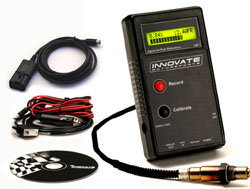 |
Everything seemed fine with the car. It had a slight hesitation as the motor transitioned from vacuum to boost but the car ran pretty good and felt strong at wide open throttle. Our air/fuel ratio was right on target so we decided to head to the track and see what it would do. This was sometime near the end of October.
The air was a little cooler and for some reason the car developed some drivability issues when putting around in the pits at Bradenton Motorsports Park. It stalled twice and then puffed black smoke on startup. The idle rpm was down to 500 (which didn't help with the stalling) so we raised the idle to 1000 with an SCT tuner just to see what would happen. We knew it wasn't right but it seemed to help so we took the car for a run down pit road. It still didn't run normal but our air/fuel ratio was on target at WOT and the car didn't stall so we headed to the staging lanes. We were the first in the lanes that night and first out on to the track. After a decent burnout the car was staged and brought up to around 3500 rpm. Yellow, yellow, yellow, green light, BOOM, the car lunged then fell on it's face and rolled about 15 feet with a lot of crunchy noise coming from the rear of the car. Now what? The car has our 1000 hp carbon fiber driveshaft and a bullet proof 9" Moser rearend, what could possibly be wrong back there? And to think we hesitated bringing the trailer. While we were pushing the car back onto the trailer, we noticed the entire rear bumper of the car was sooted up from the exhaust. Ok, we have some things to sort out before we come back.
Unfortunately I didn't take any pictures of the carnage but when we pulled the axles, one was fine and the other had no splines on it?? After disassembling the center section, it was noticed that the passenger side spline collar on the Detroit TrueTrak had a spiral fracture which allowed the axle to slip in the splines. Wonderful. After speaking with Moser about it, we shipped them both out for inspection and hopefully a warranty. It turns out that we got a bad unit (obviously) and that Eaton has redesigned the entire posi. Moser warrantied both and got us a newer model posi unit. This process took us deep into November, a time in the year when we (BMR) are very active preparing for the PRI, Fabtech and SEMA shows, not to mention Holidays. Needless to say, the car got shelved for a while. In the meantime, the car continued to run worse so we made plans to send it down south to Diablosport for further tuning.
Diablosport had the car for the month of January. It turned out that the majority of the drivability issues were caused by the position of the blowoff valve. Since the valve was positioned after the MAF, the computer was getting confused when the throttle blades closed. The MAF would read the amount of air traveling through it and add the right amount of fuel to match it. But when the throttle blades suddenly closed, the blowoff valve would vent all that air creating an overly rich mixture. A new set of plugs were installed and the blowoff valve was modified temporarily to prevent it from opening. With further tuning, Diablosport was able to find an additional 80 rear wheel horsepower under the curve, an area that makes the car "feel" much faster. The max rear wheel power remained roughly the same at 434.
They said everything looked so good that we should think about adding some more boost. Just recently they had tuned a few other Mustangs and had safely pushed them over the 500 mark without any issues. At this point it seemed that the turbo was barely even breaking a sweat so we decided to shoot for around 480-500 rear wheel horsepower. The 8 pound spring was installed and the power jumped up to somewhere in the 450's but the fuel system wasn't keeping up.
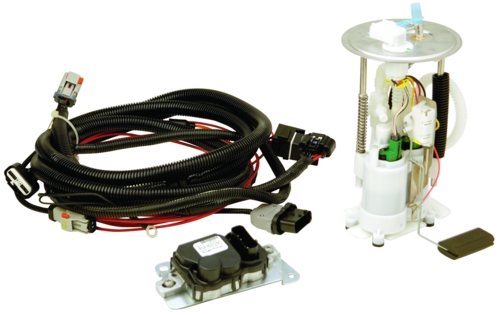 |
The best fuel upgrade short of a cell and external race pump is the fuel system out of a new GT500. This is a dual pump system and is supposed to be safe up to around 600-700 horsepower. The upgrade requires the GT500 harness and a second fuel pump modulator. Since this is all designed to fit the S197 already, the installation could not be simpler. Diablosport performed the installation and also installed the 10 psi spring. After a retune, the car made 480 rear wheel horsepower. Not bad, but is it enough for that 10 second ET? |
